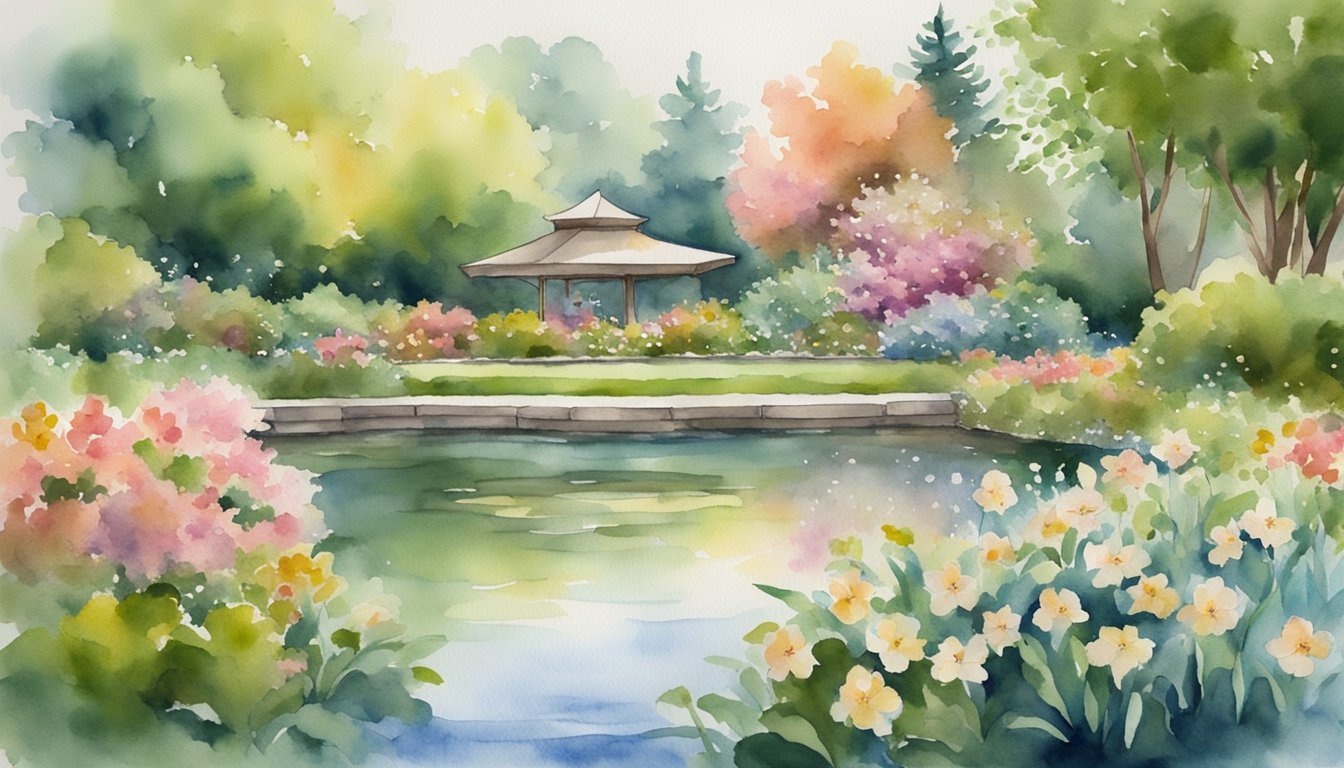8 Spiritual Practices to Overcome Fear and Anxiety: Transform Your Life Today

Are you struggling with fear and anxiety? You’re not alone.
Many people face these challenges daily, but there are spiritual practices that can help.
By tapping into your inner peace and connecting with something greater, you can find relief and overcome worry.

Spiritual techniques offer powerful ways to calm your mind and ease anxiety. Whether through prayer, meditation, or other practices, you can cultivate a sense of peace and hope.
This article will explore 8 spiritual methods to help you face your fears and find tranquility in your daily life.
Check out this resource for more guidance on your spiritual journey.
1) Meditation sessions for inner peace
Meditation can be a powerful tool to find inner peace and calm your anxious mind.
By setting aside time each day to sit quietly and focus on your breath, you allow worries to melt away.
Start with just 5-10 minutes of meditation in the morning.
Sit comfortably, close your eyes, and bring your attention to your breathing.
When thoughts arise, gently redirect your focus back to your breath.
You may find it helpful to use a guided meditation, especially when starting out.
Many apps and websites offer soothing guided meditations to walk you through the process step-by-step.
As you practice regularly, you’ll likely notice your mind becoming calmer and more centered.
Meditation teaches you to observe thoughts without getting caught up in them.
Try different styles to see what resonates with you.
Options include mindfulness meditation, loving-kindness meditation, or body scan meditations.
The key is finding an approach that helps you feel peaceful and grounded.
2) Affirmations to rewire the mind
Affirmations are powerful tools to reshape your thoughts.
By repeating positive statements, you can calm your mind and reduce anxiety.
Choose words that resonate with you and speak to your heart.
Start your day with uplifting phrases like “I am safe” or “I trust in the flow of life.” Say them out loud or write them down.
The more you practice, the more your brain will start to believe these new, peaceful thoughts.
When fear creeps in, counter it with affirming words.
Tell yourself “I am stronger than my worries” or “I choose peace over panic.” These simple sentences can shift your focus and bring you back to center.
You can even create personalized affirmations for specific situations.
If social events make you nervous, try “I am comfortable and confident around others.” Tailor your phrases to address your unique concerns.
Remember, changing thought patterns takes time. Be patient and kind with yourself as you learn this new skill.
With consistent practice, affirmations can truly transform your mindset and help you overcome fear and anxiety.
3) Breathing exercises for calm
Breathing exercises can help you find peace when anxiety strikes.
By focusing on your breath, you can slow your racing thoughts and relax your body.
A simple technique to try is belly breathing.
Place one hand on your chest and the other on your stomach.
Take a deep breath through your nose, letting your belly expand.
Exhale slowly through your mouth.
Another helpful method is the 4-7-8 breath.
Breathe in for 4 counts, hold for 7, then exhale for 8.
This pattern helps activate your body’s relaxation response.
You can practice this anywhere, anytime to reduce stress.
Box breathing is also calming.
Imagine tracing a square as you breathe.
Inhale for 4 counts, hold for 4, exhale for 4, hold for 4.
Repeat this cycle several times.
As you breathe, picture yourself becoming more grounded and centered.
Try incorporating a mantra or affirmation with your breath.
As you inhale, think “I am” and as you exhale, “at peace.” Choose words that resonate with you.
Let your breath carry away worries and bring in tranquility.
4) Guided visualizations for anxiety
Guided visualizations can help calm your anxious mind.
These mental exercises use your imagination to create soothing scenes.
You picture peaceful places or positive outcomes in detail.
One simple technique is to visualize warm, healing light.
Imagine it entering the top of your head and slowly moving down through your body.
Feel it soothing any tension as it travels from your head to your toes.
You can also picture yourself in a tranquil natural setting.
It might be a quiet beach, serene forest, or peaceful mountain top.
Use all your senses to make the scene vivid and relaxing.
Some guided visualizations lead you on an inner journey.
You might imagine climbing a mountain, leaving worries behind with each step.
At the top, you feel free and confident.
Many free guided meditation apps offer visualizations for anxiety.
These audio tracks walk you through calming mental imagery.
They can be helpful when you’re feeling overwhelmed.
With practice, you’ll learn to use visualization anytime you need to reduce anxiety.
Even a quick mental picture of a peaceful place can help center you.
5) Mindfulness practices for grounding
Mindfulness can help you feel more grounded when anxiety tries to sweep you away.
Take a moment to pause and notice your surroundings.
What do you see, hear, and feel right now?
Try this simple exercise: Take three deep breaths.
On the first breath, look around and notice five things you can see.
On the second breath, listen for four sounds.
On the third breath, feel three points of contact between your body and your surroundings.
You can also practice a body scan.
Start at your toes and slowly move your attention up through your body.
Notice any sensations without judgment.
This helps bring you into the present moment.
Mindful stretching is another great way to ground yourself.
Gently stretch your arms, legs, and back.
Pay attention to how the stretches feel in your body.
Remember, the goal is not to eliminate anxiety, but to stay present with it.
By practicing mindfulness regularly, you can build inner peace and resilience.
With time, you may find your anxiety lessens as you learn to stay grounded in the present.
6) Gratitude journaling daily

Gratitude journaling can be a powerful tool to shift your focus from fear to appreciation.
You can start by setting aside a few minutes each day to write down things you’re thankful for.
Begin with small, simple things like a warm cup of tea or a sunny day.
As you practice, you’ll find more to be grateful for in your life.
Writing about gratitude helps rewire your brain to notice the positive aspects of your experiences.
This can reduce anxiety and increase feelings of peace and contentment.
Try to be specific in your journal entries.
Instead of just writing “family,” you could note “Mom’s supportive phone call today.”
You may find it helpful to use gratitude journal prompts to spark ideas when you’re stuck.
These can guide you to reflect on different areas of your life.
Remember, there’s no right or wrong way to keep a gratitude journal.
The key is consistency and sincerity in your practice.
7) Yoga poses for relaxation
Yoga can be a powerful tool to calm your mind and body.
Certain poses help release tension and promote relaxation.
Child’s pose is a great place to start.
You curl up with your forehead on the mat, arms extended.
This pose soothes your nervous system.
Another helpful pose is legs-up-the-wall.
You lie on your back with your legs resting vertically against a wall.
This gentle inversion eases anxiety and quiets racing thoughts.
Forward folds are also deeply calming.
Standing or seated, you bend forward, letting your upper body hang heavy.
This stretches tight back muscles and calms your mind.
Restorative yoga uses props to support your body in gentle poses held for several minutes.
This allows you to fully relax and let go of stress.
Remember to breathe deeply and slowly in each pose.
Focus on the sensations in your body.
With regular practice, these yoga poses can help you find inner peace and tranquility.
8) Chanting mantras for strength
Chanting mantras can be a powerful way to build inner strength and overcome anxiety.
You can start with simple Sanskrit mantras like “Om” or “So Hum” to connect with your divine essence.
Try repeating “I am strong” or “I am capable” as personal mantras.
Say them out loud or silently to yourself throughout the day.
This practice helps rewire your thoughts toward positivity and confidence.
Choose mantras that resonate with you personally.
As you chant, focus on the meaning and let the words sink into your being.
Visualize yourself embodying the strength and calm you seek.
Consistency is key.
Set aside a few minutes each day to chant your chosen mantras.
You may find it helpful to use mala beads to count repetitions.
With regular practice, you’ll likely notice a shift in your mindset.
Remember, the power of mantras lies in your belief and intention.
As you chant, open your heart to receive strength and peace.
Trust in the process and be patient with yourself.
To learn more about using mantras for anxiety relief, check out this helpful resource.
The Power of Meditation
Meditation is a powerful tool for calming your mind and easing fear and anxiety.
It helps you connect with your inner self and find peace amidst life’s challenges.
Mindfulness Meditation
Mindfulness meditation focuses on being present in the moment.
You pay attention to your breath, bodily sensations, and thoughts without judgment.
This practice helps you observe anxious thoughts without getting caught up in them.
To start, find a quiet spot and sit comfortably.
Close your eyes and focus on your breathing.
Notice the air moving in and out.
When your mind wanders, gently bring your attention back to your breath.
Try this for 5-10 minutes daily.
Over time, you’ll find it easier to stay present and let go of worries. Mindfulness can reduce stress and improve your overall well-being.
Guided Visualization
Guided visualization uses your imagination to create calming mental images.
It’s a great way to relax your body and mind.
You can use recorded guides or create your own peaceful scenes.
Picture yourself in a serene place, like a beach or forest.
Use all your senses – feel the warmth of the sun, hear the waves or birds, smell the fresh air.
As you imagine this peaceful scene, your body relaxes and tension melts away.
This guided meditation program offers excellent visualizations to reduce anxiety.
Regular practice can help you feel more centered and less fearful in daily life.
Embracing Affirmations
Affirmations can be a powerful tool to shift your mindset and calm your fears.
These positive statements help you focus on your strengths and build inner peace.
Positive Self-Talk
You have the power to change your thoughts.
When you catch yourself thinking negatively, pause and reframe those ideas in a positive way.
Instead of “I can’t handle this,” try saying “I am capable of facing challenges.” Write down encouraging phrases and keep them where you’ll see them often.
Stick post-it notes with uplifting messages on your mirror or computer.
Read them out loud each day.
Over time, these affirmations will sink in and become part of how you think about yourself.
Try using a guided affirmation program to help you get started with positive self-talk.
These tools can provide structure as you build this new habit.
Daily Mantras
Choose short, meaningful phrases to repeat to yourself each day. “I am at peace” or “I trust in life” are good options to begin with.
Say your mantra when you wake up, before bed, and anytime you feel anxious during the day.
You can also create your own mantras based on what you need most.
If you struggle with self-doubt, try “I believe in myself and my abilities.” For fears about the future, use “I am safe and all is well.”
Write your favorite mantras in a journal or on your phone.
Read through them often.
The more you repeat these words, the more your mind will start to believe them.
Connecting with Nature

Nature offers powerful ways to ease anxiety and find peace.
Spending time outdoors can help you feel grounded and connected to something larger than yourself.
Grounding Exercises
Try these simple practices to connect with the earth:
- Walk barefoot on grass or sand
- Sit with your back against a tree
- Dig your hands into soil while gardening
- Lie on the ground and feel it supporting you
Focus on your senses as you do these exercises.
Notice how the earth feels beneath you.
Breathe deeply and imagine roots growing from your body into the ground.
These grounding techniques can help calm your nervous system and reduce stress.
Regular practice may improve your overall wellbeing.
Nature Walks
Taking walks in nature is a great way to clear your mind and lift your mood.
Try these tips:
- Choose a quiet trail or park
- Walk slowly and mindfully
- Notice the sights, sounds, and smells around you
- Look for small details like interesting leaves or rocks
- Take deep breaths of fresh air
Even short nature walks can help you feel more relaxed and centered.
Try to get outside for at least 15-30 minutes a day if you can.
If you live in a city, seek out parks, gardens, or tree-lined streets.
Connecting with any bit of nature can be beneficial.
Frequently Asked Questions

Spiritual practices offer powerful tools to overcome fear and anxiety.
Let’s explore some common questions about using spirituality to find peace and calm.
What are some spiritual strategies to help soothe fear and anxiety?
Meditation is a key practice for inner peace.
Try sitting quietly for 5-10 minutes each day, focusing on your breath.
You can also use positive affirmations like “I am safe and at peace” to rewire your thoughts.
Gentle breathing exercises calm your nervous system.
Can spiritual practices provide relief from anxiety, and if so, which ones are most effective?
Yes, spiritual practices can greatly reduce anxiety.
Guided visualizations are very effective – imagine a peaceful scene in detail using all your senses.
Mindfulness is also powerful.
Focus on the present moment, noticing your surroundings without judgment.
What role does faith play in battling against feelings of fear and apprehension?
Faith provides comfort and hope during hard times.
It reminds you that you’re not alone and that a higher power is watching over you. Praying or talking to God can ease worries.
Trusting in a divine plan brings peace.
How can one utilize Biblical teachings to find peace and reduce anxiety?
Many Bible verses offer comfort for anxiety.
Philippians 4:6-7 says “Do not be anxious about anything, but pray about everything.” Meditate on uplifting passages.
The Psalms contain many prayers for peace and protection.
In what ways can connecting with spirituality promote a calm and fearless mindset?
Spirituality helps you see the bigger picture beyond daily stresses.
It teaches acceptance and surrender.
Practices like yoga blend physical and spiritual for mind-body calm.
Nature walks can spark awe and peace.
What authentic spiritual exercises can help release the burden of fear from our minds?
Journaling your fears then releasing them through prayer or ritual can be freeing.
Loving-kindness meditation cultivates compassion for yourself and others.
Gratitude practices shift your focus to the positive. Energy healing may help release emotional blocks.

